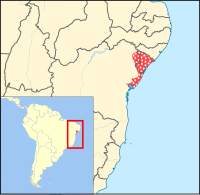Coimbra Filho's titi
| Coimbra Filho's titi | |
|---|---|
| Scientific classification | |
| Kingdom: | Animalia |
| Phylum: | Chordata |
| Class: | Mammalia |
| Order: | Primates |
| Family: | Pitheciidae |
| Genus: | Callicebus |
| Species: | C. coimbrai |
| Binomial name | |
|
Callicebus coimbrai Kobayashi & Langguth, 1999 |
|
 |
|
| Geographic range | |
Coimbra Filho's titi (Callicebus coimbrai) or just Coimbra's titi is a species of titi, a type of New World monkey, endemic to forests in the Brazilian states of Bahia and Sergipe. It was first discovered by Shuji Kobayashi. It is considered one of the most endangered of all Neotropical primates. It is named after Adelmar F. Coimbra-Filho, founder and Former Director of the Rio de Janeiro Primate Centre, in honor of his work in the field of Brazilian primatology and biology.
The most distinct of Coimbra Filho's titi's features, from other members of the personatus group, include its black forehead, crown, and ear area, as well as a zebra-like pattern on the anterior of its back. Coimbra Filho's titi is also differentiated from other members of the personatus group by the shape of both its skull and its teeth. Compared to other members of its group, the skull is smaller, and shaped slightly differently. Its teeth are also more U-shaped, as opposed to the more V-shaped teeth exhibited by other members of the personatus group. It also features different dental topography on its upper first and second molars when compared to other members of the group.
The preferred habitat for Coimbra Filho's titi consists of densely wooded areas, preferring the dense understory and lower canopy. However, it is able to survive in damaged or fragmented forests, which currently comprise a large portion of its range. This is due to a tolerance to highly disturbed areas, as well as the ability to subsist in areas composed primarily of young or second growth forests. While other species in Callicebus are native to many areas of South America from Colombia to Brazil, Peru and north Paraguay, Coimbra Filho's titi is found only in a very small area in the states of Bahia and Sergipe in coastal northeastern Brazil.
...
Wikipedia

